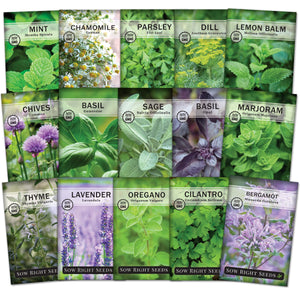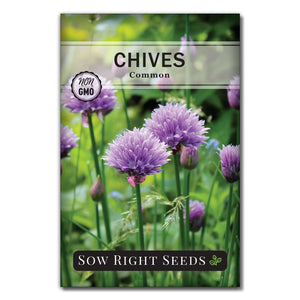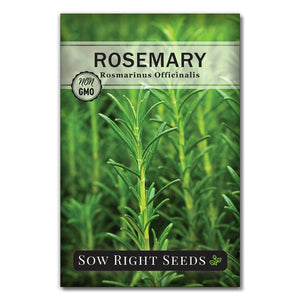Learn How to Grow Marjoram - The Secret Ingredient Herb
Herb growing tipsMost likely, you’ve had marjoram in a variety of dishes and never knew it. Marjoram is the secret ingredient herb that makes a recipe have that special something. Herbs de Provence and bouquet Garni both depend on the flavor of marjoram. A close relative to oregano, marjoram’s flavor is milder and sweeter. The citrus and pine notes of marjoram will remind you of a mix of oregano and basil.

Marjoram (Origanum majorana) is a perennial in zones 9 and 10 but grown as an annual everywhere else. Marjoram will grow well in dry, rocky soil with full sun.
How to grow marjoram from seed
Growing marjoram from seed is an inexpensive and easy way to start marjoram plants. Marjoram is cold-sensitive and will need to be grown indoors when temperatures are below 50ºF.
Seeds can be started outdoors or indoors. However, starting marjoram seeds indoors is usually more successful. Also, by starting seeds indoors, you can get a jump on the growing season by sowing seeds 6 to 8 weeks before the last spring frost.
Marjoram seeds need warmth and light to germinate. Sow marjoram seeds 1/8” deep. Use a heating mat to keep the soil at 65º to 70ºF for germination. Seeds will start sprouting in 7 to 15 days.
Place grow lights close to the seedlings to keep them from stretching to the light and becoming spindly.
Water from the bottom after the marjoram seeds have sprouted to avoid damping off.
Tips for fail-proof marjoram seed germination
Keep soil temperature at 65º to 70ºF
Barely cover marjoram seeds, 1/8”
Light is needed for germination
Use a humidity dome to keep the soil moist until seeds have sprouted.
Transplanting Marjoram
When marjoram seedlings have several true leaves and an established root system, they will be ready to transplant outside.
Make sure all danger of frost is past as marjoram is cold-sensitive. Temperatures should be consistently above 50ºF before placing marjoram plants outdoors.
Hardening off seedlings is a critical step for successful marjoram transplanting. Take time to gradually acclimate your plants to outdoor conditions. Over the course of a week or two, place seedlings outdoors in a spot sheltered from intense sun and wind. Start with one hour a day and increase the time by an hour each day.
Once seedlings have been hardened off, plant marjoram in a sunny location. It should have direct sun for a minimum of 6 to 8 hours a day.
Space marjoram plants 12” to 18” apart.
How to grow marjoram plants
Marjoram thrives in full sun and dry soil. Once your marjoram plants are established, they can tolerate drought conditions.
Like most Mediterranean herbs, marjoram doesn’t need rich soil or lots of fertilizer. Grow marjoram in loamy soil that drains well. Don’t add fertilizer unless growing in a container.
Water marjoram plants when the soil is dry below one inch. Although marjoram is drought tolerant, you’ll have better flavor if the plants are not stressed.
Pruning or pinching back the growth tips of your marjoram plant will promote branching. This will result in a bushier plant.
Marjoram can be grown with other plants that share similar growing conditions, like rosemary, thyme, and lavender.
How to grow marjoram plants in containers
Marjoram makes an excellent container plant. Since it is cold-sensitive, marjoram grown in containers can be moved indoors to keep growing during the cold winter months. However, if grown indoors, marjoram will need adequate light. Use grow lights and a monthly application of a balanced fertilizer for healthy indoor plants.
Solutions for marjoram pests and diseases
Marjoram is not susceptible to specific pests other than the usual aphids and spider mites common to all plants.
Root rot and fungal diseases can be mitigated by proper watering. Avoid overhead watering and make sure the soil drains well.

Harvesting marjoram
You can start harvesting leaves when your marjoram plant is at least six inches tall. Clip off marjoram sprigs and strip the leaves to use fresh or dried. Never take off more than 1/3 of the plant at a time.
Marjoram Uses
As a culinary herb, marjoram is used both fresh and dried. Marjoram is the magic ingredient in herbed bread and soups. Dried marjoram is more potent than fresh and is usually added in the first part of cooking. Fresh marjoram is usually added in the last few minutes of simmering.
Because of its antioxidant and anti-inflammatory properties, marjoram is used in anti-aging remedies. It is also used for cleansing and healing for skin and scalp.
FAQs About Marjoram
Is marjoram the same as oregano?
Marjoram is in the same family as oregano and has a sweeter and milder taste. Marjoram and oregano can be substituted for each other, but the flavor will be slightly different.
Does marjoram come back every year?
Cold temperatures will kill off marjoram plants. However, it will self-seed, and the seeds will sprout in the spring. Or you can sow new seeds each year.
Marjoram is an easy herb to grow from seed. Its flavor is an important part of herbs de Provence and bouquet Garni. Even though it can be substituted with oregano, its unique flavor deserves its own spot in your herb garden. Try growing marjoram and see what a difference it makes in your culinary world.










Leave a comment